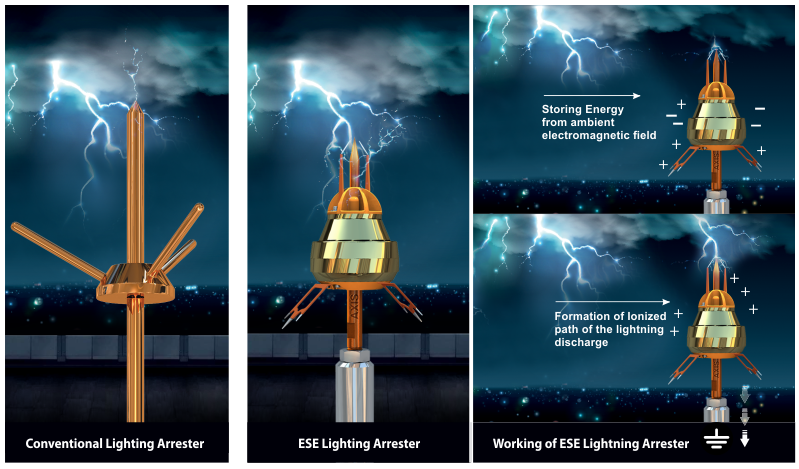Follow us on LinkedIn for regular updates on everything about Lightning Arresters!
Well, we all are aware of the lightning strike that occurs during the rainy season. But are we aware of the fact that we need to protect our structure and electrical system from it too? Yes, there is a device called a lightning arrester. There are different types of lightning arresters, they protect our structure & electrical systems from getting affected by lightning. In this article, we will discuss the difference between Conventional and ESE Lightning Arresters. Let’s start off by discussing the working principle of lightning arresters.

Basics of the Lightning Arrester
A lightning bolt generates a voltage surge. And it directly hits on any facility or electrical service. The wiring or the electrical systems of the facility may get damaged due to the voltage surge.
Hence to protect the structure and electrical systems, the lightning arresters are used.
The lightning arrester defends the power system by forwarding this high voltage surges to the ground. The lightning arrestor provides the low impedance path when the traveling wave of lightning reaches a certain level and gets grounded without affecting the structure. For more info on lightning arresters, feel free to read this blog on “Why do we need Lightning Arresters?” Now, we will discuss the clear difference between the conventional lightning arrester and ESE lightning arrester by understanding their working.
Free Book on ESE Lightning Arrester
Types of Lightning Arrester – Conventional
The conventional lightning arrester consists of Franklin rods. Their effectiveness is decided based on their position, morphology, materials used, and physical reaction that is performed due to the electrostatic field during the lightning.
The lightning arrester is placed at a dominant height, making it a favourable point for the lightning bolt to strike. Through the grounding system, the positive charge rises to the tip of the lightning rod. And when the lightning strikes, the device allows the lightning leader from the cloud and grounds it safely through the installed grounding system. Hence the current discharge gets distributed evenly throughout the ground and thus protects the structure.
Types of Lightning Arrester – ESE
The key purpose of using the ESE lightning arrester is to become the fast conductive point of discharge for the lightning bolt & ground current safely. Hence instead of hitting random objects or the structure of the facility, the lightning bolt will conduct through the ESE lightning arrester and the high voltage spike will get grounded safely.
The main difference between a conventional lightning arrester and an ESE lightning arrester is the response time (ΔT) taken to ground the lightning strike through the lightning protection system. The response time for ESE IS reduced by storing energy from the ambient electromagnetic field or static charges at the time of the lightning.
The ESE lightning arrester can cover a larger radius compared to a traditional lightning arrester. As per NFC 17-102, the ΔT for an ESE Lightning Arrester should be at least 10μs. At Axis Electrical Components, we have a range of products from the ΔT of 10μs to 60μs. Generally, the ΔT gets defined as per the area & requirement of the project.
Watch the video to understand the difference in detail
Conclusion (i.e the difference)
The ESE lightning arrester system will respond faster when compared to conventional lightning arresters. The ESE system will not hit random objects such as structures, solar panels, electrical or communication lines, etc.
Key takeaways:
The larger radius can be protected using the ESE lightning arrester.
For the lightning protection of the larger fields or solar parks, the ESE lightning arrester becomes inexpensive considering their protection radius.
The ESE lightning arrester does not just protect structures but also the open surroundings too.
In addition, ESE systems are easier to install in complex architectural environments and require fewer rods.
They are ideal for modern infrastructure where uninterrupted operations are critical.
Choosing the right type of arrester based on project size, budget, and risk assessment ensures optimal lightning protection and long-term safety.
We hope this article will help you understand the clear difference between the conventional lightning arresters and ESE lightning arresters. Thank you for reading until the end. To know more about our products, click here or feel free to email us.








